Japan
Wood Products Prices
Dollar Exchange Rates of 25th
Mar
2024
Japan Yen 151.46
Reports From Japan
Japan raises interest rates for
first time in 17 years
The Bank of Japan announced on 19 March an end to
negative interest rates and a review other ultra-loose
monetary policies that have been in place for more than a
decade to buoy the stagnant economy. This comes as
wages jumped after consumer prices rose. In 2016 the
bank cut the rate below zero in an attempt to stimulate the
country's stagnating economy.
The BoJ will also raise its interest rate on part of the
balance of current account deposits that commercial banks
hold at the central bank from minus 0.1% to plus 0.1%.
The unconventional policy was aimed at encouraging
banks to increase lending to businesses.
In addition, the BoJ will abolish a policy framework,
known as yield curve control, designed to keep long-term
interest rates low by purchasing government bonds. The
policy change in Japan means that there are no longer any
countries left with negative interest rates.
Business Federation urges government to combat
deflation
Masakazu Tokura, chairman of the Japan Business
Federation known as Keidanren said that the Federation
hopes the government will take necessary measures to
fully combat the country's decades-long deflation. He is
quoted as saying "It is important for the country to work as
one to make this year a historic turning point in
completely overcoming deflation that has continued for 30
years."
This call by the Federation appears to have been heard by
the Government as, in a budget speech, the Japanese Prime
Minister said that Japan is "only halfway" to ending
deflation, pledging to continue implementing measures to
achieve a virtuous cycle of wage and price rises. The
government plans tax cuts and policy changes to help
companies continue with wage increase in a bid to realise
disposable income growth among consumers.
A recent Nikkei survey of top executives between 26
February and 13 March just 50% of respondents say the
economy is "expanding" or "expanding slightly", down
from 72.5% in the December survey. This marks the
lowest reading since the March 2022 poll where only 13%
expected any expansion.
Corporate leaders have grown less upbeat on the economy
in recent months signaling a cautious stance ahead of wage
hikes that could begin to boost spending later this year.
Hiroyuki Isono, president and group CEO of paper
company Oji Holdings "Because of the prolonged
inventory adjustments, along with the weak consumer
spending and the weak Chinese economy, it remains
unclear when the manufacturing sector will recover."
Orders for machinery down in January
The Cabinet Office has reported the total value of
machinery orders received by 280 surveyed manufacturers
operating in Japan fell by almost 3% in January from the
previous month. Private-sector machinery orders,
excluding volatile ones for ships and those from electric
power companies, decreased a seasonally adjusted by 2%
in January.
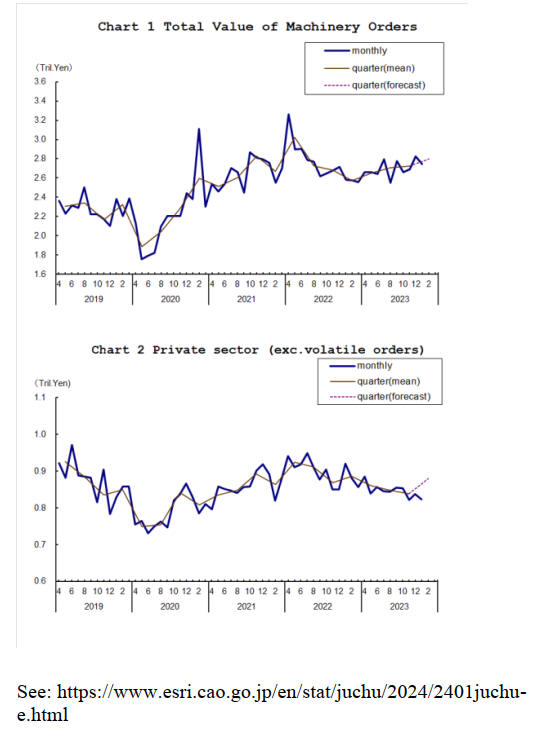
Part-time worker wages below that of full time
employees
The major Japanese corporations have agreed record pay
rises signaling the employers have finally stopped holding
back on pay in order to to build up their dash reserves.
This comes after around 30 years of extremely low
nominal wage growth.
In past years, Japanese companies had been
preoccupied
with controlling production costs in the face of global
competition but the labour shortage has proven, again, that
when supply cannot meet demand prices (in this case
wages) go up.
Japan has one of the world's oldest populations which has
led to a decline in the number of working-age individuals
making it challenging for companies to fill job vacancies.
Another issue is that companies took advantage of recent
laws allowing an increase in the number of so-called ‘part-
time workers’ whose wages are below that of full time
employees.
Japan lags far behind other big economies in minimum
wages and the minimum wage in Japan was 45% of
median full-time wages in 2022. The percentage of
workers in Japan whose income was below the new
minimum-wage level when it was raised in fiscal 2022
came to 19%, a sharp rise from an earlier survey reflecting
an increase in part-time workers.
See:
https://asia.nikkei.com/Spotlight/Market-Spotlight/Japan-s-wage-hikes-create-game-changing-inflation-dynamic-as-BOJ-meets
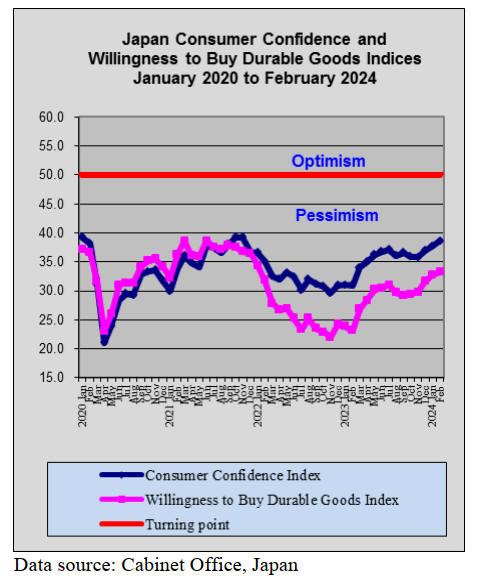
Residential property growth slowing
Data compiled in the Global Property Guide indicates
Japan’s residential property growth is slowing amidst
falling demand and weakening construction activity.
During the third quarter of 2023 the nationwide residential
property price index rose by a modest 2.4% from a year
earlier, a slowdown from y-o-y increases of 4.8% in the
second quarter and 4.1% in the first quarter according to
the Land Institute of Japan.
See:
https://www.lij.jp/monthly.html
and
https://www.globalpropertyguide.com/
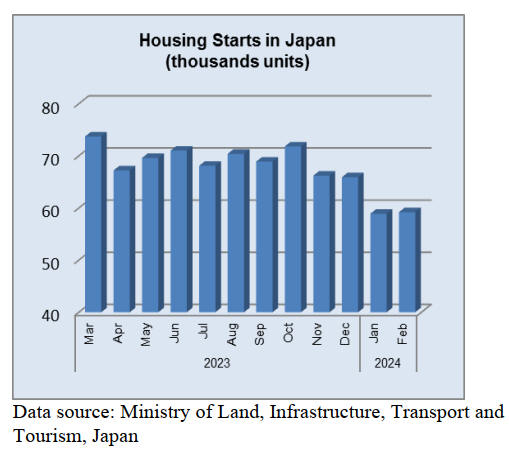
Japan – the the last major economy to end
negative
interest rate policy
After the Bank of Japan (BoJ) ended its negative interest
rate policy, the last major economy to do so, the yen fell
sharply against the US dollar.
The US dollar hit a four-month high of yen 154 recently
way beyond the lowest seen in October 2022 when Japan
carried out so-called stealth interventions, buying yen to
sell dollars without announcing the moves immediately.
The yen’s recent weakness reflects a view among market
players that the BoJ is unlikely to raise interest rates
further anytime soon as premature tightening of monetary
policy with additional interest rate increases could quickly
undo the gains made in tackling deflation and the benefits
to exporters of a weak currency.
See:https://asia.nikkei.com/Business/Markets/Japanese-yen-slides-past-150-after-BOJ-decision-to-raise-rates

Import update
Assembled wooden flooring imports
Imports of assembled wooden flooring (HS441871-79) in
January 2024 were at around the same value as in
December 2023, a pattern that has been consistent in most
years reflecting the quiet demand due to the construction
sector holidays in January.
Year on year the value of January 2024 imports was down
15% which, when viewed against the rate at which the yen
has weakened over the past 12 months signals a significant
decline in the volume imported.
In January the main category of assembled flooring
imports was HS441875 accounting for around 70% of the
total value of assembled flooring imports. The second
largest category in terms of value was HS441873
exceeding that of HS 441879.
The main shippers of assembled flooring in January were
China 59%, up from slightly from a month earlier, the US
12%, Vietnam 11% with a further 6% being shipped from
Indonesia.
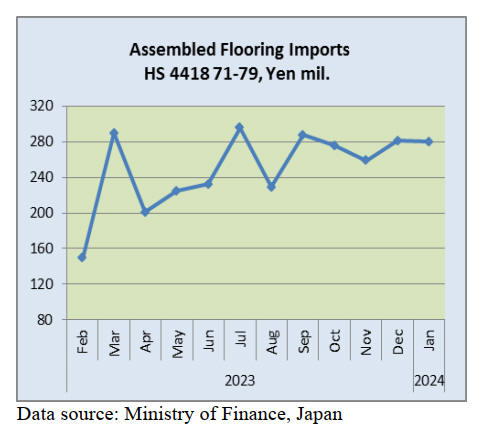
Plywood imports
Of the four main suppliers of plywood (HS441210-39) to
Japan it was only those in Indonesia that did not see a rise
in shipments in January. Month on month there was a rise
in import volumes from Malaysia in January (50,175
cu.m) but a decline in the volume from Indonesia (52,288
cu.m).
The volume of plywood imports from Vietnam in January
was, once again, higher than that from China and was up
month on month. Plywood imports from China began to
decline in mid 2022 and bottomed out in mid 2023 and
since have started to recover but are far from levels seen
prior to 2022.
Of the various categories of plywood imported, 85% was
HS441231 in January with HS441233 and HS441234
accounting for around 5% each. The four main shippers of
plywood to Japan, Indonesia, Malaysia, Vietnam and
China consistently account for over 90% of plywood
imports.
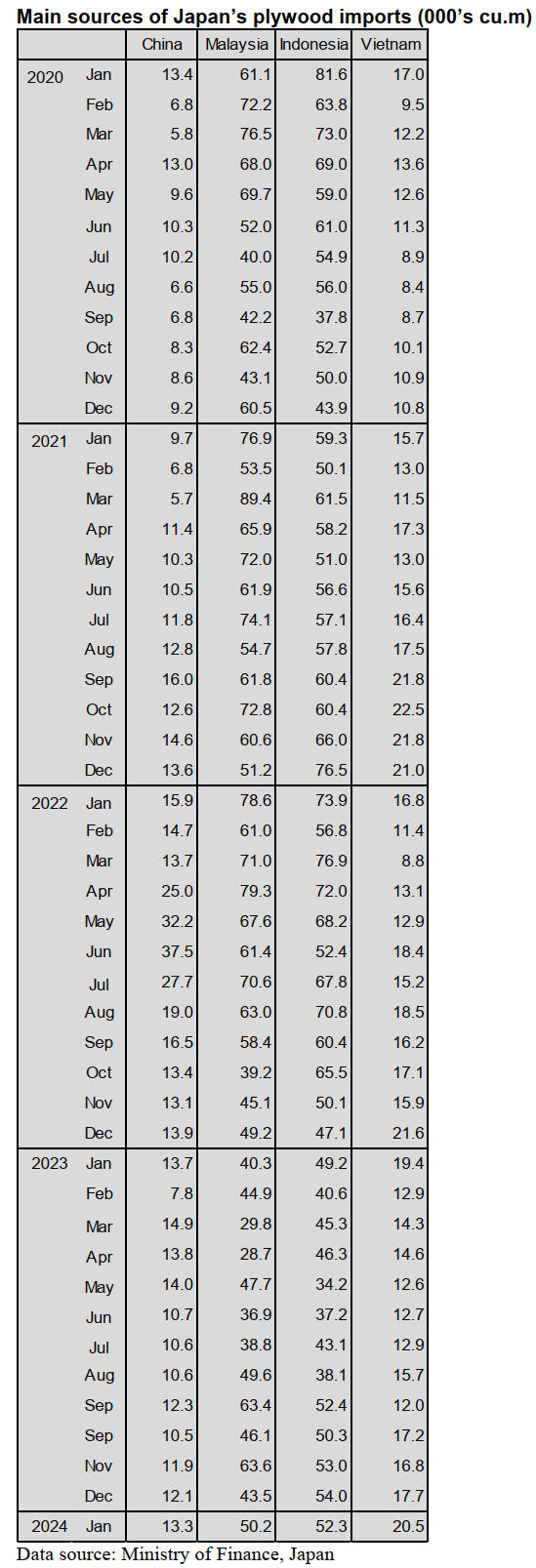
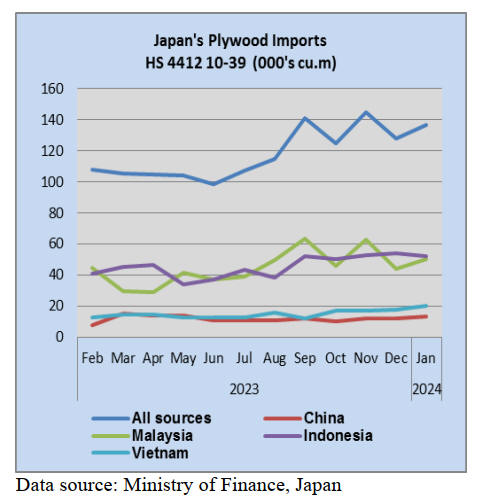
Trade news from the Japan Lumber Reports (JLR)
The Japan Lumber Reports (JLR), a subscription trade
journal published every two weeks in English, is
generously allowing the ITTO Tropical Timber Market
Report to reproduce news on the Japanese market
precisely as it appears in the JLR.
For the JLR report please see:
https://jfpj.jp/japan_lumber_reports/
Quake damages in Noto Peninsula in Ishikawa
Prefecture
There has been heavy damage at mountains and forests in
Noto Peninsula in Ishikawa Prefecture due to the massive
earthquake. Production of raw material in 2022 was
113,000 cbms in Ishikawa Prefecture. About 30 – 40 % of
raw materials are from Wajima City, Suzu City and Noto
town where are damaged by the earthquake badly.
Forest Owners’ Co-operative Association in Ishikawa
Prefecture announced that three forest associations
Ishikawa Prefecture, which had less damage by the
earthquake, will supply raw materials for a forest
association of Noto. The forest associations aim to supply
a level of 90,000 cbms of raw materials annually.
South sea logs and lumber
Movement of hardwood still sluggish. Demand have been
dull and movement of deck or laminated boards is
sluggish. yen is 150 yen against the dollar and it is not
good timing to purchase lumber.
Demand for South Sea lumber and Chinese lumber have
not been increasing and the distributors in Japan expect to
purchase lumber when the yen is strong.
Especially, the price of South Sea lumber is high in South
Asia because of less South Sea logs so the foreign
exchange is very important for Japanese buyers to
purchase South Sea lumber or not.
The price of laminated boards in South Asia is
unchanged
from the previous month. Production is high in South
Asia so laminated board manufacturers would not lower
the price.
Imported South Sea logs and lumber in 2023
Import of South Sea logs in 2023 is 30,749 cbms, 34.8 %
less than 2022. Import of South Sea lumber in 2023 is
136,298 cbms, 15.4 % less than last year. Imported
laminated board in 2023 is 160,930 cbms, 16.4 % less than
last year. Reasons are that there is low demand for South
Sea logs and lumber in Japan and there are not enough
South Sea logs in South Asia.
Local manufacturers in the state of Sabah and the state of
Sarawak, Malaysia reduced producing South Sea lumber
so there were not a lot of South Sea logs.
Logs in Papua New Guinea, which exports logs to China
the most, were less because there were not a lot of
inquiries from China due to the sluggish economy in
China. Some manufacturers in Papua New Guinea, which
produce and export logs and lumber to Japan, struggled to
purchase logs through a year. South Sea products are
popular for blocks for steels and for truck bodies in Japan.

|